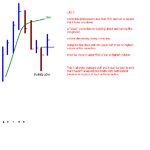Good points guys. You're highlighting the need for sticking to a basic strategy and having a trading plan. Along with Risk and Money Management I couldn't agree more. What I am (was?) having difficulty with was defining the purely strategy-side of my game.
Since my earlier post this morning I've realised 2 things.
1. The problem I had with analysing charts to support what I was trying to do here were they essentially felt 'lifeless'. Apart from the sheer overwhelm of even just 6 primary factors and their inter-relationships, there was a sense of 'something missing' And there is. LII and T&S.
Although LII and T&S don't feature in my primary setup criteria - they do ultimately determine when
and if I hit the button on a trade.
So trawling through hundreds of 'dead' EOD charts wasn't going to do it. I'd forgotten what else I use (need?) to be effective in my trading. Which brings me to my 2nd realisation.
2. I switched from EOD to intraday some time back and posted not too long ago that when other non-trading commitments impact my schedule, I simply switch to a longer timeframe and trade. Which I did. In these situations, the LII and T&S had less prominence (if any at all on many trades) and I kidded myself I was doing just as well on the longer timeframes as on my normal intraday ones. Although I do not keep detailed statistics on my trades these days, a cursory look back at my bottom-line during that EOD period shows significantly less success. Still profitable, but nowhere near my normal levels. Sure, this could be a temporal thing and I could have fared as badly during that period even trading intraday, but I somehow doubt it.
It's a classic case of not being aware consciously of market information which I have Unconsciously inculcated - i.e. my use of LII and T&S.
Which rather exacerbates the problems I mentioned earlier in any attempt to codify or systemise strategies.
It's not just the complexity of considering ALL the factors you use when trading - it's actually being aware enough of them to shake a stick at them in the first place.

It's Sunday - why am I here...?




